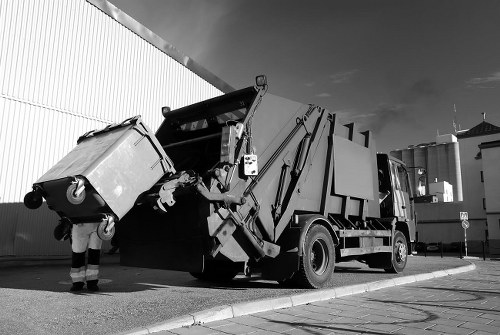Loft Clearance in House Clearance
Understanding Loft Clearance

Loft clearance is a specialized segment of house clearance that focuses on clearing out the loft or attic spaces within a home. These areas often accumulate forgotten items over the years, making loft clearance essential for maintaining a clutter-free and functional living environment.
Whether you're preparing to sell your home, moving to a new place, or simply wanting to declutter, loft clearance plays a critical role in enhancing the overall appeal and safety of your property. Clearing out the loft can also improve insulation and ventilation, contributing to a more energy-efficient home.
Engaging professional loft clearance services ensures that the process is handled efficiently, safely, and in compliance with any local regulations regarding waste disposal and recycling. Professionals have the expertise and equipment needed to manage large or difficult-to-remove items, making the clearance process smoother for homeowners.
The Importance of Loft Clearance in House Clearance

Loft spaces are often out of sight and easy to neglect, leading to a buildup of unnecessary items such as old furniture, forgotten memorabilia, and unused household appliances. This accumulation can create safety hazards, especially in older homes where structural integrity may already be compromised.
Additionally, a cluttered loft can impede proper airflow and insulation, leading to increased energy bills and uncomfortable living conditions. By conducting regular loft clearances, homeowners can ensure that their lofts remain functional storage areas that contribute positively to the home's overall condition.
Moreover, in the context of house clearance, loft clearance is vital for presenting a clean and organized space to potential buyers. A well-maintained loft can add value to your property and make it more attractive in a competitive real estate market.
Steps Involved in Loft Clearance

Loft clearance involves several key steps to ensure the process is thorough and efficient:
- Assessment: Evaluating the loft space to determine the volume and nature of items to be cleared.
- Sorting: Categorizing items into those to keep, donate, recycle, or dispose of.
- Removal: Safely transporting items out of the loft, often requiring specialized equipment.
- Cleaning: Ensuring the loft is clean and free of debris after clearance.
- Disposal: Properly disposing of unwanted items in accordance with local regulations.
Benefits of Professional Loft Clearance Services

Hiring professionals for loft clearance offers numerous advantages:
- Efficiency: Professionals can complete the clearance process quickly, saving you time and effort.
- Safety: Experts are trained to handle heavy and awkward items, reducing the risk of injury.
- Proper Disposal: Professionals ensure that items are disposed of responsibly, adhering to environmental regulations.
- Stress Reduction: Delegating the task to professionals alleviates the burden of managing the clearance yourself.
- Comprehensive Service: Many companies offer additional services such as cleaning and minor repairs post-clearance.
Preparing for Loft Clearance

Before initiating loft clearance, proper preparation is crucial to ensure a smooth process:
- Plan Ahead: Schedule the clearance at a convenient time, allowing ample space for the removal process.
- Clear Access: Ensure that pathways to and from the loft are unobstructed to facilitate easy movement of items.
- Identify Hazardous Materials: Remove any dangerous substances or fragile items that require special handling.
- Communicate with Professionals: Provide clear instructions and expectations to the clearance team regarding specific requirements.
- Sort Belongings: Pre-sort items to streamline the clearance process, making it more efficient.
Eco-Friendly Loft Clearance Practices
In today's environmentally conscious world, eco-friendly loft clearance practices are increasingly important. Professionals focus on sustainable methods to minimize the environmental impact:
- Recycling: Items such as metals, electronics, and paper are sorted and recycled appropriately.
- Donation: Usable items are donated to charitable organizations, giving them a second life.
- Responsible Disposal: Non-recyclable and non-donatable items are disposed of in accordance with local environmental guidelines.
- Minimizing Waste: Efficient sorting and categorization reduce the amount of waste sent to landfills.
Adopting these practices not only benefits the environment but also aligns with many homeowners' values of sustainability and responsible living.
Cost Factors in Loft Clearance
The cost of loft clearance can vary based on several factors, including:
- Size of the Loft: Larger lofts require more time and resources to clear.
- Volume of Items: More items mean increased labor and disposal costs.
- Accessibility: Lofts with limited access may require special equipment, adding to the cost.
- Type of Items: Bulky or hazardous items may incur additional fees for safe handling and disposal.
- Location: Accessibility and local disposal regulations can influence the overall cost.
It's advisable to obtain multiple quotes and understand the pricing structure before committing to a loft clearance service.
Choosing the Right Loft Clearance Service
Selecting a reputable loft clearance service is essential for a successful clearance. Here are some tips to help you make the right choice:
- Experience: Look for companies with a proven track record in loft clearance.
- Credentials: Ensure the service is licensed and insured to protect against any potential damages or liabilities.
- Reviews and Testimonials: Check customer feedback to gauge the quality of service provided.
- Transparency: Choose a service that offers clear pricing with no hidden fees.
- Sustainability: Prefer services that follow eco-friendly practices in their clearance process.
Taking the time to research and select the right professional can make a significant difference in the outcome of your loft clearance.
Post-Clearance Loft Maintenance
After completing loft clearance, maintaining the space is important to prevent future clutter:
- Regular Inspections: Periodically check the loft for any signs of disorganization or unwanted items.
- Proper Storage Solutions: Invest in shelving, containers, and labeling systems to keep items organized.
- Climate Control: Ensure the loft is properly insulated and ventilated to protect stored items from moisture and pests.
- Limit Access: Restrict access to the loft to prevent accidental accumulation of clutter.
- Scheduled Clean-ups: Set reminders for occasional clean-ups to maintain a tidy loft space.
Consistent maintenance can help preserve the benefits of loft clearance, ensuring the space remains functional and clutter-free.
Common Challenges in Loft Clearance
Loft clearance can present several challenges, including:
- Limited Accessibility: Small or steep staircases can make moving large items difficult.
- Heavy Items: Bulky furniture or appliances require additional manpower and equipment to remove.
- Hazardous Materials: Presence of asbestos, chemicals, or other dangerous substances necessitates specialized handling.
- Emotional Attachment: Letting go of sentimental items can be emotionally taxing for homeowners.
- Time Constraints: Tight schedules can pressure the clearance process, leading to potential oversights.
Addressing these challenges requires careful planning, the right resources, and professional assistance to ensure a safe and efficient clearance.
Legal Considerations in Loft Clearance
When undertaking loft clearance, it's important to be aware of any legal requirements:
- Permits: Some jurisdictions may require permits for the removal of certain items or for extensive clearance projects.
- Disposal Regulations: Ensuring items are disposed of according to local laws, especially for hazardous or electronic waste.
- Building Codes: Compliance with building codes related to structural integrity and safety during the clearance process.
- Insurance: Verify that the clearance service has adequate insurance coverage in case of accidents or damages.
- Privacy Laws: Respecting privacy by securely disposing of personal documents and sensitive information.
Understanding and adhering to these legal considerations helps prevent potential issues and ensures that loft clearance is conducted responsibly.
Loft Clearance and Home Renovation
Loft clearance often coincides with home renovation projects. Clearing the loft can provide a fresh canvas for remodeling, allowing homeowners to reconfigure storage spaces or repurpose the area:
- Creating Additional Living Space: Transforming the loft into a bedroom, office, or recreational area.
- Enhancing Storage Capacity: Installing built-in shelving or storage units to maximize space utilization.
- Improving Insulation: Upgrading insulation during clearance can enhance energy efficiency.
- Installing Lighting: Adding proper lighting fixtures to make the loft more functional and inviting.
- Structural Modifications: Reinforcing the loft structure to support new installations or uses.
Integrating loft clearance with renovation efforts can significantly enhance the functionality and aesthetics of your home.
DIY vs. Professional Loft Clearance
Deciding between DIY loft clearance and hiring professionals depends on several factors:
- Scope of the Project: Large or complex clearances may be beyond the capabilities of a DIY approach.
- Physical Limitations: Heavy lifting and moving large items can be challenging without assistance.
- Time Availability: Professionals can complete the clearance more quickly, which is beneficial for time-sensitive projects.
- Cost: While DIY may save money upfront, potential damages or improper disposal can lead to higher costs in the long run.
- Expertise: Professionals have the knowledge and experience to handle various items and situations effectively.
For many homeowners, the benefits of professional loft clearance—such as safety, efficiency, and comprehensive service—outweigh the costs associated with hiring experts.
Maximizing Space Post-Clearance
After clearing the loft, it's important to organize the space effectively to prevent future clutter:
- Use Clear Containers: Transparent boxes allow you to see contents easily, reducing the need to open each container.
- Label Everything: Clear labeling helps in identifying items quickly, enhancing organization.
- Optimize Vertical Space: Install shelving or hooks to make use of vertical areas for storage.
- Implement a Rotation System: Regularly rotate items based on usage frequency to keep the space tidy.
- Invest in Multi-Purpose Furniture: Incorporating furniture that serves multiple functions can save space and improve utility.
Strategic organization post-clearance ensures that the loft remains a functional and clutter-free area, maximizing the benefits of the clearance process.
Case Studies: Successful Loft Clearance Projects
Examining real-life examples of successful loft clearance projects can provide valuable insights:
- Residential Home in London: A family successfully cleared their loft, turning it into a functional home office, improving their work-from-home experience.
- Renovation Project in Manchester: A couple cleared a cluttered loft and transformed it into a cozy guest bedroom, increasing the property's market value.
- Eco-Friendly Clearance in Birmingham: Homeowners opted for a professional service that focused on recycling and donation, significantly reducing their environmental footprint.
- Emergency Clearance in Bristol: Following storm damage, a prompt loft clearance by professionals helped in repairing and restoring the home efficiently.
- Small Loft in Edinburgh: Maximizing limited space through strategic clearance and smart storage solutions enhanced the overall functionality of the loft.
These case studies highlight the diverse benefits and applications of loft clearance in various contexts, demonstrating its importance in home management and improvement.
Frequently Asked Questions about Loft Clearance
Addressing common questions can help homeowners better understand loft clearance:
- How long does a loft clearance take? The duration depends on the size and condition of the loft, but typically it can range from a few hours to a full day.
- What items are typically removed during loft clearance? Common items include old furniture, clothing, memorabilia, broken appliances, and unused equipment.
- Is loft clearance expensive? Costs vary based on factors like loft size, volume of items, and specific service requirements. Obtaining quotes from multiple providers is recommended.
- Can I donate items during loft clearance? Yes, many clearance services offer donation options for usable items, supporting charitable organizations.
- How do professionals handle hazardous materials? Certified clearance services follow strict protocols for the safe removal and disposal of hazardous materials.
Conclusion
Loft clearance is an integral part of house clearance, offering numerous benefits including improved safety, enhanced space utilization, and increased property value. Whether you're undertaking a renovation, preparing to sell, or simply seeking to declutter, professional loft clearance services provide the expertise and efficiency needed to transform your loft into a functional and organized space.
Investing in loft clearance not only enhances your living environment but also contributes to a more sustainable and orderly home. By understanding the process, choosing the right professionals, and maintaining the cleared space, homeowners can fully realize the advantages of a well-managed loft.
Ready to transform your loft? Contact us today to schedule your professional loft clearance and take the first step towards a more organized and efficient home.